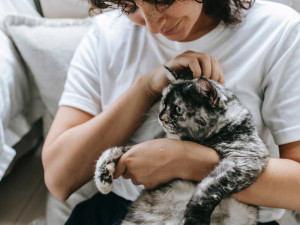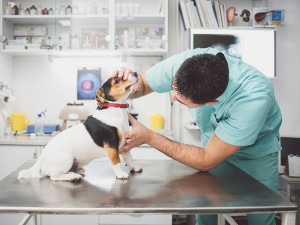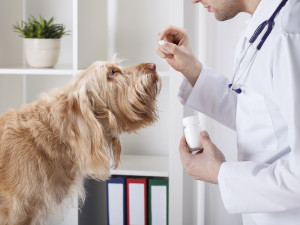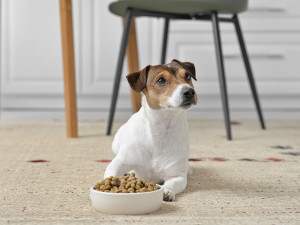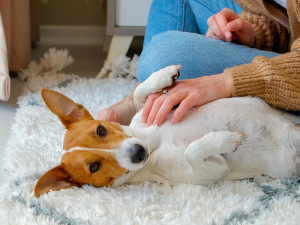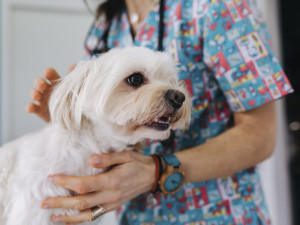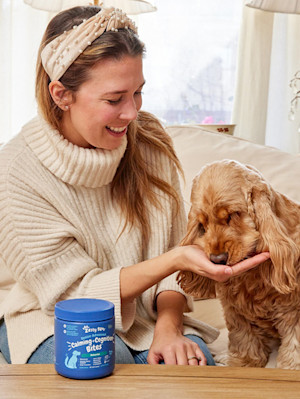Guide to Swollen Lymph Nodes in Dogs
Here’s how to figure out if they’re swollen, and what to do if they are enlarged.
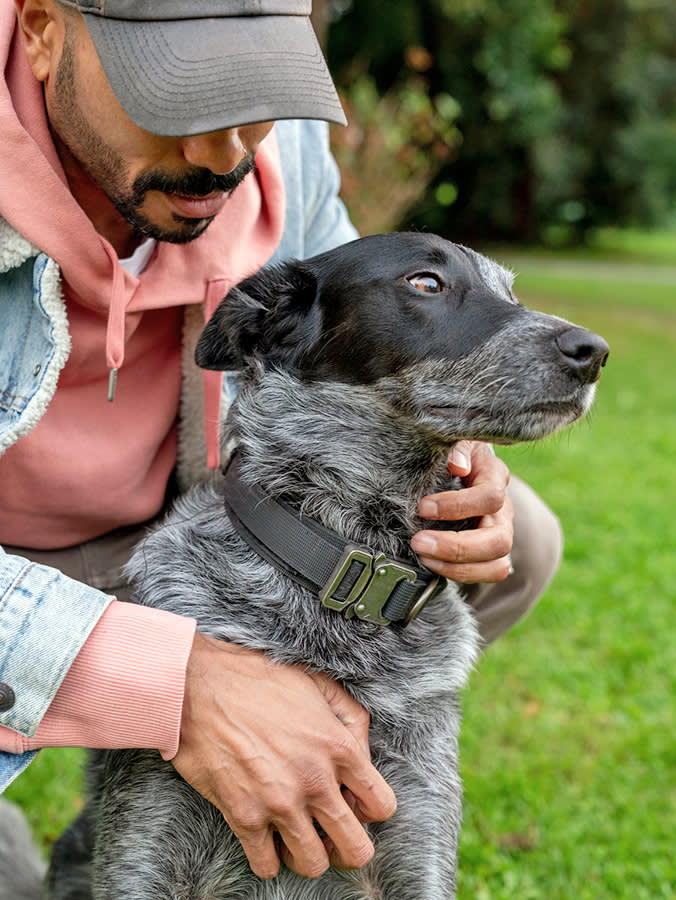
Share Article
In This Article:
Causes of Swollen Lymph Nodes Symptoms of Swollen Lymph Nodes Diagnosing Swollen Lymph Nodes Treatment Options Prevention and Management When to See a Veterinarian
The lymph nodes are unsung heroes in a pup’s body, despite being essential parts of their immune system. They are invaluable, yet often don’t get a lot of recognition or hype — that is, until something goes wrong.
Normally, lymph nodes stay fairly hidden, going about their business under the radar. But when your dog’s lymph nodes become swollen, watch out. This can be a little scary if you’re not sure what you’re looking at or why this is happening. We’ll walk you through what swollen lymph nodes in dogs look like, what could be causing them, and what you should do when you spot them.
Causes of swollen lymph nodes in dogs
Lymph nodes are part of the lymphatic systemopens in new tab and the immune system. These tiny nodules filter the lymph fluid and store white blood cells, so that they’re ready to attack should they need to fight an illness.

Lymph nodes are small and can rarely be seen or felt when they’re operating normally. But once they detect an illness, they really put on a show and can grow up to 10 times their normal size. They may swell due to being overrun with immune cells (in response to an infection), or because they are filling up with cancer cells. Here are the three main causes of lymphadenopathy, which is the enlargement of lymph nodes.
Reactive hyperplasia: This is when lymph nodes grow in size because they are responding to an invader (such as bacteria or a virus) by storing up extra white blood cells.
Lymphadenitis: This is the next step up, when the lymph nodes receive an overflow of inflammatory cells to fight an active infection.
Neoplasia: Because lymph nodes filter the lymph fluid, they can collect cancer cells from nearby neoplasms and grow in size. They will also enlarge with cancer of the lymphatic system (also called lymphomaopens in new tab).
Symptoms of swollen lymph nodes in dogs
When lymph nodes swell, they become larger and more noticeable. Sounds pretty easy to detect, right? Well, only if you know where to look. Our pups have five main types of lymph nodes; these are their specific locations:
Submandibular: where the lower jaw meets the neck
Prescapular: where the neck meets the chest, just in front of the shoulder blades
Axillary: behind the front legs where they meet the chest
Popliteal: behind the knee on the rear legs
Inguinal: in the groin
You may be able to feel them when they’re not swollen (if you’re looking in the right place), and they will feel small and firm. You’ll find them just under the skin and will be able to move them around. But when they become swollen, they become very noticeable, even under a dog’s coat. Instead of feeling firm, swollen lymph nodes will often be soft and squishy, as well as warm and even sore to the touch.
Depending on which lymph nodes are swollen, dogs may have difficulty swallowing. Additionally, they may not want to eat, be lethargic, have a fever, vomit, and lose weight.
Diagnosing swollen lymph nodes in dogs
Lymphadenopathy is a symptom rather than a disease. So instead of your vet diagnosing that the lymph nodes are swollen, they’ll want to dig into why they are swollen.
Veterinary exams
Your vet’s going to start by giving your dog a good going over. They’ll check temperature, feel around for lumps and bumps, and listen to the heart and lungs. You can help out by letting your vet know when you first noticed the swelling and any other changes that you’ve seen in your pup, such as appetite or weight changes.
Diagnostic tests
Your vet will then run some tests, which may include bloodwork to look at organ function and blood cell numbers. They will also probably take a sample of the lymph node to see whether immune cells or cancer cells are behind the recent enlargement. From there, imaging may be necessary to look for other issues, and your vet may recommend further testing for specific illnesses that aren’t covered by basic bloodwork.
Treatment options for swollen lymph nodes
There are three main treatments for swollen lymph nodes.
Medication
Infections that cause lymph node swelling will likely require medication. Antibiotics and anti-inflammatories will help knock out bacterial infections and fight inflammation. Fluids and other supportive care may also be necessary. Some types of cancer may be treated with medications as well.
Surgery
Your vet may try to remove tumors or abscesses — this could include removing the local lymph node if it is diseased as well. Following the surgical removal of a cancerous tumor, your vet will probably recommend chemotherapy or radiation to get rid of any remaining cancer cells.
Lifestyle
Dogs with swollen lymph nodes aren’t going to feel great, so you’ll need to give your dog a little downtime. If they have an infection, keep them away from other dogs to prevent transmission and follow your veterinarian’s guidelines for treatments and follow-ups.
Prevention and management of swollen lymph nodes
Some dogs have more reactive lymph nodes than others, which means they seem to swell at the very idea of an infection. These dogs may need a little lifestyle adjustment, which includes staying up-to-date on vaccines — but potentially spacing them out, so the pup is only receiving one at a time. You may also want to avoid germ-factory locations such as the dog park, the groomer, or a boarding facility. You should also make sure your dog is as healthy as can be by giving them a high-quality diet, plenty of exercise, and regular veterinary attention.
When to see a veterinarian for swollen lymph nodes in dogs
Swollen lymph nodes are the body’s natural reaction when faced with something unnatural such as an infection or cancer. If your dog’s lymph nodes are swollen, they likely need some professional help, especially if you’re noticing other signs such as a fever, not eating, vomiting, or lethargy.
If your dog’s lymph nodes are only slightly enlarged, and there’s nothing else abnormal going on, you may choose to monitor them closely for a few days to see if they continue to grow or if other signs arise.
Bottom line
The lymph nodes act as filters and storage units for the lymphatic system and the immune system.
When all is normal, you probably won’t even know they are there. But when confronted with an infection or cancer, they can become very enlarged and swollen.
See your veterinarian if your dog’s lymph nodes are overly swollen, remain swollen, or are accompanied by other signs of illness.
References
“How Lymph Nodes on Dogs Work and Why They’re Important.” Imprimed. 3 Oct 2023. https://www.imprimedicine.com/blog/lymph-nodesopens in new tab.
“Lymphoma in Dogs Fact Sheet.” Davies Veterinary Specialists. https://www.vetspecialists.co.uk/fact-sheets-post/lymphoma-in-dogs-fact-sheet/opens in new tab.

Dr. Chyrle Bonk, DVM
Dr. Chyrle Bonk has been a mixed-animal veterinarian since 2010, with a special interest in rehabilitation. When she's not practicing or writing about veterinary medicine, you may find her exploring the outdoors with her family or tending to her cows, horses, chickens, or cats and dogs.
Related articles
![A vet holding medicine near a dogs face]()
How to Find a Veterinary Specialist
Just like your doctor would refer to you a specialist for expert care for a complicated issue, your vet may do the same for your dog.
![A dog sitting on the floor with a bowl of kibble.]()
Everything You Need to Know About Your Dog’s Gut Microbiome
Microscopic organisms may reveal pathways to better health for your pet.
![Jack Russel Terrier mixed breed dog laying on his back on a white and gray rug getting his belly rubbed by his owner]()
How to Do a DIY Dog Checkup in 7 Steps
You can do a DIY exam on your dog from your couch.
Does Your Dog Need a Flu Shot?
“Sick as a dog” isn’t just a phrase.
![Smiling veterinarian examining medical documents of a Bulldog standing on her examination table]()
How to Give Your Dog a Blissful Vet Visit
Reduce the stress of veterinary visits — for you and your pup.
![Woman feeding her dog a supplement at home.]()
7 Supplements to Help Each of Your Dog’s Health Concerns
From dry skin to anxiety to allergies, we've got a supplement to help your pup’s specific needs.
